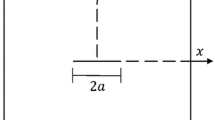Abstract
This paper investigates the T-stress in the branch crack problem. The problem is modeled by a continuous distribution of dislocation along branches, and the relevant singular integral equation is obtained accordingly. After discretization of the singular integral equation, the balance for the number of equations and unknowns is well designed. After the singular integral equation is solved, the equation for evaluating the T-stress is derived. The merit of present study is to provide necessary equation for evaluating T-stress, rather than to provide the integral equation. Many computed results for T-stress under different conditions for branch crack are presented. It is found from the computed results that the interaction for T-stress among branches is complicated.
Similar content being viewed by others
References
Ayatollahi MR, Pavier MJ, Smith DJ (1998) Determination of T-stress from finite element analysis for mode I and mixed mode I/II loading. Inter J Fract 91: 283–298
Boiko AV, Karpenko LN (1981) On some numerical methods for the solution of the plane elasticity problem for bodies with cracks by means of singular integral equation. Int J Fract 17: 381–388
Bourton JK, Phoenix SL (2000) Superposition method for calculating singular stress fields at kinks, branches and tips in multiple crack arrays. Int J Fract 102: 99–139
Broberg KB (2005) A note on T-stress determination using dislocation arrays. Int J Fract 131: 1–14
Chen YZ, Hasebe N (1995) New integration scheme for the branch crack problem. Eng Fract Mech 52: 791–801
Chen YZ, Hasebe N, Lee KY (2003) Multiple crack problems in elasticity. WIT Press, Southampton
Chen YZ, Lin XY (2008) Comments on “Approximate Green’s functions for singular and higher order terms of an edge crack in a finite plate” by Xiao and Karihaloo [Eng Fract Mech 2002;69:959–981]. Eng Fract Mech 75:4844–4848
Chen YZ, Wang ZX, Lin XY (2008) Crack front position and crack back position techniques for evaluating the T-stress at crack tip using functions of a complex variable. J Mech Mater Struct 3: 1659–1673
Cotterell B, Rice JR (1980) Slightly curved or kinked cracks. Inter J Fract 16: 155–169
Daux C, Moes N, Dolbow J, Sukumar N, Belytschko T (2000) Arbitrary branched and intersecting cracks with the extended finite element method. Int J Numer Meth Eng 48: 1741–1760
Dutta BK, Kakodkar A, Maiti SK (1991) Two singular points finite elements in the analysis of kinked cracks. Comp Mech 7: 329–339
Englund J (2006) Stable algorithm for the stress field around a multiply branched crack. Int J Numer Meth Eng 63: 926–946
Fett T (1999) A Green’s function for T-stresses in an edge cracked rectangular plate. Eng Fract Mech 57: 365–373
Fett T (2001) Stress intensity factors and T-stress for internally cracked circular disks under various conditions. Eng Fract Mech 68: 1119–1136
Fett T, Rizzi G, Bahr HA (2006) Green’s functions for the T-stress of small kink and fork cracks. Eng Fract Mech 73: 1426–1435
Karihaloo BL, Xiao QZ (2001) Higher order terms at the crack tip asymptotic field for a notched three-point bend beam. Int J Fract 112: 111–128
Li XF, Xu LR (2007) T-stresses across static crack kinking. ASME J Appl Mech 74: 181–190
Lo KK (1978) Analysis of kinked crack. ASME J Appl Mech 45: 797–802
Melin S (1986) On singular integral equations for kinked cracks. Inter J Fract 30: 57–65
Melin S (1994) Accurate data for stress intensity factors at infinitesimal kinks. ASME J Appl Mech 61: 467–470
Muskhelishvili NI (1953) Some basic problems of mathematical theory of elasticity. Noordhoff, Groningen
Rice JR (1974) Limitations to the small scale yielding approximation of elastic–plastic crack-tip fields. J Mech Phys Solids 22: 17–26
Savruk MP (1981) Two-dimensional problems of elasticity for body with crack. Naukoya Dumka, Kiev (in Russian)
Theocaris PS (1977) A symmetric branching of cracks. ASME J Appl Mech 44: 611–618
Yang B, Ravi-Chandar K (1999) Evaluation of elastic T-stress by stress difference method. Eng Fract Mech 64: 589–605
Yavuz AK, Phoenix SL, TerMaath SC (2006) An accurate and fast analysis for strongly interacting multiple crack configurations including kinked (V) and branched (Y) cracks. Inter J Solids Struct 43: 6727–6750
Williams ML (1957) On the stress distribution at the base of a stationary crack. ASME J Appl Mech 24: 111–114
Author information
Authors and Affiliations
Corresponding author
Rights and permissions
About this article
Cite this article
Chen, Y.Z., Lin, X.Y. Evaluation of the T-stress in branch crack problem. Int J Fract 161, 175–185 (2010). https://doi.org/10.1007/s10704-010-9451-3
Received:
Accepted:
Published:
Issue Date:
DOI: https://doi.org/10.1007/s10704-010-9451-3



